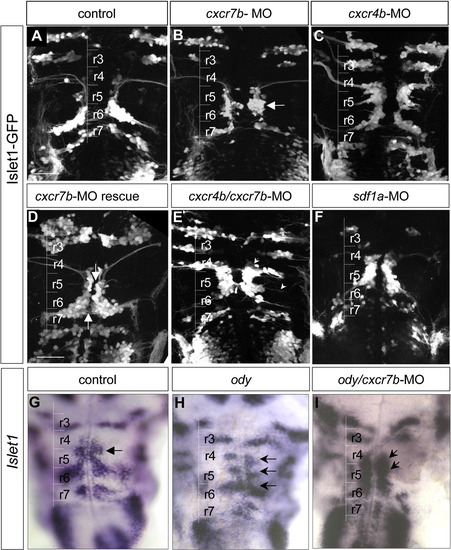Fig. 5
|
CXCR7b and CXCR4b are required for proper motoneuron migration. (A) In a control 48 hpf embryo, Isl1-GFP positive cells accumulate in r6. (B) ln cxcr7b-MO, most Isl1-GFP positive cells accumulate in r5 (arrow). (C) In cxcr4b-MO embryo, Isl1-GFP positive cells are present in r4 and r5, reflecting a partial impairment of migration. (D) In cxcr7b-mRNA injected (600 pg) embryos, a partial rescue is observed with no more accumulation in r5 but many Isl1-GFP cells remained close to the midline from r4 to r6 (arrows). (E) Double inactivation of cxcr4b and cxcr7b by MO results in facial migration defects compared to control Islet-1-GFP embryos (A). The most severe phenotype was characterized by GFP positive cell accumulation in r4 and r5 and an almost complete absence of cells in r6. Ectopic dendrites can be seen contralaterally (arrow) or toward the periphery (arrowhead). (F) A similar phenotype is observed in sdf1a-MO embryos: few cells are visible in r6 while motoneurons accumulate in r4 and r5. (G–I) Double ody/cxcr7b-MO embryos at 42 hpf (I) were compared to wild type (G) and to ody embryo (H) using Islet-1 in situ hybridization. In control, Islet-1 is expressed by facial motoneurons in r6 and by the abducens nucleus in r5 (arrow, G). Note that cells accumulate mainly in r4, r5 and r6 in ody mutant (H, arrows) while in ody/cxcr7b-MO Islet-1 cells are found in r4 and r5 with few cells in r6 (I, arrows), similar to the double morphant embryos (E). In all comparisons, control and mutant embryos were age-matched. Scale bar: 50 μm. |
Reprinted from Molecular and cellular neurosciences, 40(4), Cubedo, N., Cerdan, E., Sapede, D., and Rossel, M., CXCR4 and CXCR7 cooperate during tangential migration of facial motoneurons, 474-484, Copyright (2009) with permission from Elsevier. Full text @ Mol. Cell Neurosci.

